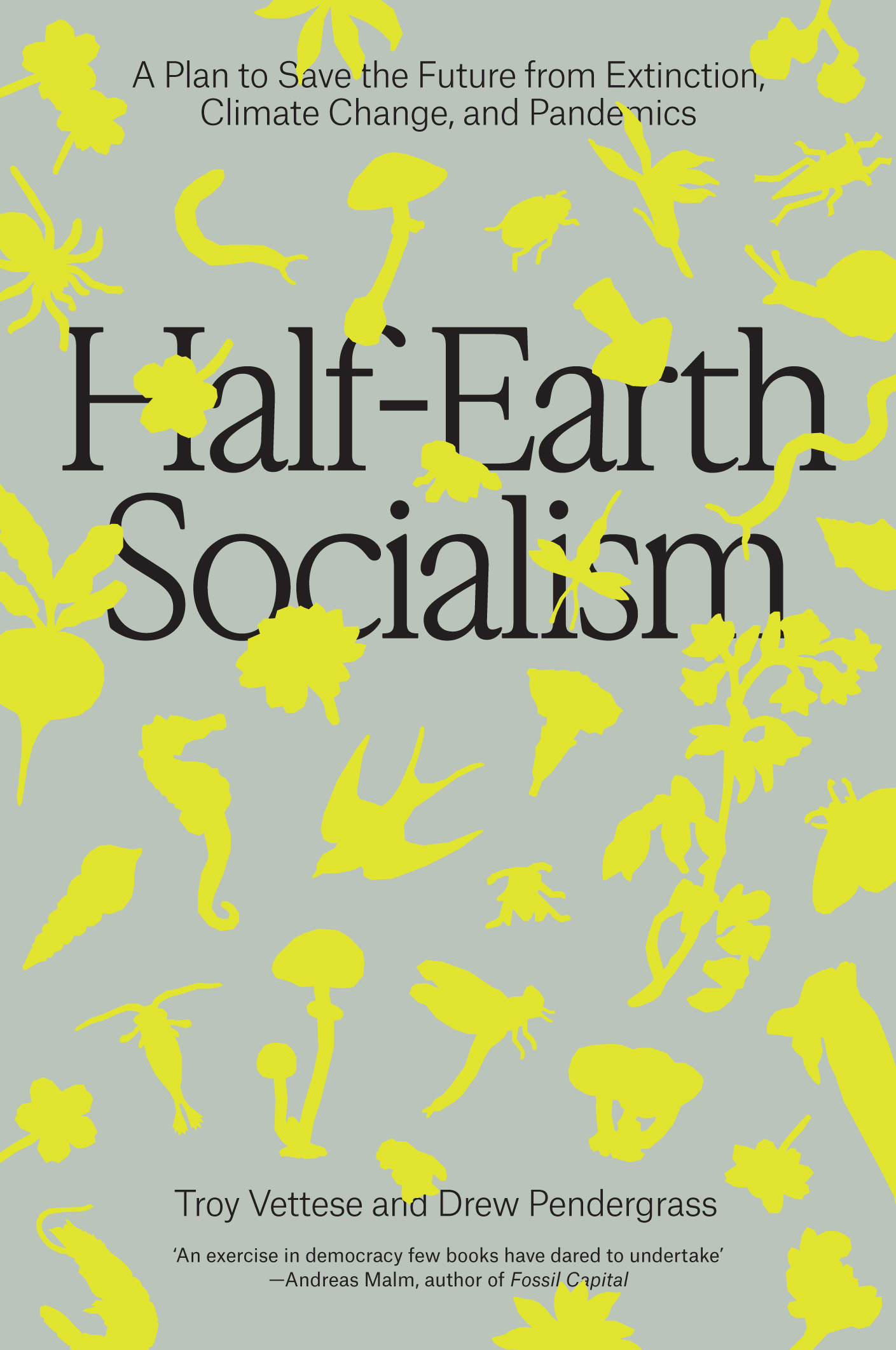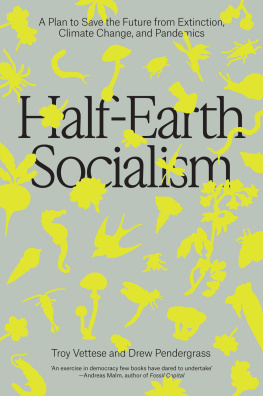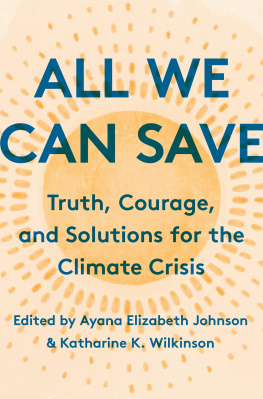Troy Vettese - Half-Earth Socialism: A Plan to Save the Future from Extinction, Climate Change, and Pandemics
Here you can read online Troy Vettese - Half-Earth Socialism: A Plan to Save the Future from Extinction, Climate Change, and Pandemics full text of the book (entire story) in english for free. Download pdf and epub, get meaning, cover and reviews about this ebook. publisher: Verso, genre: Romance novel. Description of the work, (preface) as well as reviews are available. Best literature library LitArk.com created for fans of good reading and offers a wide selection of genres:
Romance novel
Science fiction
Adventure
Detective
Science
History
Home and family
Prose
Art
Politics
Computer
Non-fiction
Religion
Business
Children
Humor
Choose a favorite category and find really read worthwhile books. Enjoy immersion in the world of imagination, feel the emotions of the characters or learn something new for yourself, make an fascinating discovery.
- Book:Half-Earth Socialism: A Plan to Save the Future from Extinction, Climate Change, and Pandemics
- Author:
- Publisher:Verso
- Genre:
- Rating:4 / 5
- Favourites:Add to favourites
- Your mark:
- 80
- 1
- 2
- 3
- 4
- 5
Half-Earth Socialism: A Plan to Save the Future from Extinction, Climate Change, and Pandemics: summary, description and annotation
We offer to read an annotation, description, summary or preface (depends on what the author of the book "Half-Earth Socialism: A Plan to Save the Future from Extinction, Climate Change, and Pandemics" wrote himself). If you haven't found the necessary information about the book — write in the comments, we will try to find it.
Troy Vettese: author's other books
Who wrote Half-Earth Socialism: A Plan to Save the Future from Extinction, Climate Change, and Pandemics? Find out the surname, the name of the author of the book and a list of all author's works by series.
Half-Earth Socialism: A Plan to Save the Future from Extinction, Climate Change, and Pandemics — read online for free the complete book (whole text) full work
Below is the text of the book, divided by pages. System saving the place of the last page read, allows you to conveniently read the book "Half-Earth Socialism: A Plan to Save the Future from Extinction, Climate Change, and Pandemics" online for free, without having to search again every time where you left off. Put a bookmark, and you can go to the page where you finished reading at any time.
Font size:
Interval:
Bookmark:
This eBook is licensed to Matthew Davies, mtdavies07@gmail.com on 05/16/2022

Half-Earth Socialism
This eBook is licensed to Matthew Davies, mtdavies07@gmail.com on 05/16/2022
Half-Earth Socialism
A Plan to Save the Future
from Extinction, Climate
Change, and Pandemics
Troy Vettese and
Drew Pendergrass

This eBook is licensed to Matthew Davies, mtdavies07@gmail.com on 05/16/2022
First published by Verso 2022
Troy Vettese and Drew Pendergrass 2022
All rights reserved
The moral rights of the editor and authors have been asserted
1 3 5 7 9 10 8 6 4 2
Verso
UK: 6 Meard Street, London W1F 0EG
US: 20 Jay Street, Suite 1010, Brooklyn, NY 11201
versobooks.com
Verso is the imprint of New Left Books
ISBN-13: 978-1-83976-031-0
ISBN-13: 978-1-83976-032-7 (UK EBK)
ISBN-13: 978-1-83976-033-4 (US EBK)
British Library Cataloguing in Publication Data
A catalogue record for this book is available from the British Library
Library of Congress Cataloging-in-Publication Data
A catalog record for this book is available from the Library of Congress
Typeset in Sabon by MJ & N Gavan, Truro, Cornwall
Printed in the UK by CPI Group
This eBook is licensed to Matthew Davies, mtdavies07@gmail.com on 05/16/2022
To our parents
This eBook is licensed to Matthew Davies, mtdavies07@gmail.com on 05/16/2022
Contents
This eBook is licensed to Matthew Davies, mtdavies07@gmail.com on 05/16/2022
A map of the world that does not include Utopia is not worth even glancing at, for it leaves out the one country at which Humanity is always landing. And when Humanity lands there, it looks out, and, seeing a better country, sets sail. Progress is the realisation of Utopias.
Oscar Wilde
We enter into Utopias proper and new-found space: the education of desire. This is not the same as a moral education towards a given end: it is, rather, to open a way to aspiration, to teach desire to desire, to desire better, to desire more, and above all to desire in a different way.
E. P. Thompson,
quoting Miguel Abensour
This eBook is licensed to Matthew Davies, mtdavies07@gmail.com on 05/16/2022
Is it so incomprehensible that the people today cry out for utopias, for powerful presentations of their future fate?
Otto Neurath
Looking Backward: 2047
In the autumn of 2029, after many years of ravaging the cities and hamlets of poor nations, climate change proved itself capable of bringing even the heartland of global capitalism to its knees. Swollen by the unseasonably warm waters in the north-west Atlantic, a hurricane of unprecedented ferocity left an arc of destruction from Washington, DC, to Boston. Powerful storm surges deluged coastal towns and strong winds downed power lines, leaving 30 million people in darkness for weeks. As emergency crews dug through the rubble, even the most fanatical Republicans could no longer deny the effects of climate change. A consensus, reached in a candle-lit session of Congress, was not to decarbonize the energy system, but rather to deploy a radical and untested technology called solar radiation management (SRM) to ensure such a calamity would never again befall the United States.
The government contracted a start-up, spun from an Ivy League laboratory, to douse the heavens with a sulphuric mist. High-flying military jets were retrofitted to dump a payload of atmosphere-altering sulphur into the stratosphere. The resulting stratoshield of reflective aerosols blocked out the sun by Rather than seeing SRM as a dangerous and desperate measure, optimists portrayed it as a demonstration of American statesmanship, technology, and entrepreneurial pluck.
Soon, however, the costs of the SRM programme became impossible to overlook. A pernicious development was the sulphuric aerosols steady erosion of the ozone layer a protective shield upon which all earthly life depends. The geoengineers assured the public that an ozone-neutral aerosol would soon be found. They experimented with diamonds and engineered nanoparticles, and for a time they were especially excited by calcium carbonate because its alkalinity appeared capable of reversing the ozone layers acidification. By the 2040s more than a decade into the SRM programme there was still no long-term solution to the problem. At this point SRM could not simply be switched off, because the high concentrations of greenhouse gases would heat the atmosphere all at once in what scientists called termination shock.
While the threat to the ozone layer lingered on the horizon, SRMs disruption of various global weather systems was a clear and present danger. The most worrying was the weakening of the monsoon, which threatened the livelihood of tens of millions of Indian farmers. Through diplomacy and generous restitution, Washington managed to talk Delhi out of its threats to shoot down the American SRM fleet, but it was uncertain whether a similar agreement could be brokered with Moscow or Beijing if those governments confronted
To ward off accusations of climate imperialism, geoengineers claimed that SRM was actually in the interest of poor nations. Such experiences contrasted sharply with SRMs impacts in the core capitalist states, where quotidian life continued more or less as normal save for the nearly permanent overcast weather. Even then, many saw blue skies as an inevitable casualty of modernity, much like electrifications extinction of starry nights a century before.
SRM marked the beginning of the end for the environmental movement. With chemicals partially blocking the energy source for solar panels, investors panicked and funds for With the stratoshield in place, the imperative to abolish the fossil-fuel industry slackened. While SRM returned a measure of climatic and economic stability (if only in the rich North), this new global thermostat proved unable to reverse the decline of the biosphere. The macabre drum beat of habitat loss and extinctions continued unabated. Ecologists despaired at the disappearance of countless species whose life cycles were disoriented by the syncopated seasons and shocks of freak weather. Unabated carbon pollution threw off the oceans chemistry to the point where only the hardiest creatures could survive in the vast acidic wastes. Sulphuric aerosols created acid rain that poisoned forests and lakes, undoing one of the great triumphs of environmental activism during the 1980s.
In sum, these events spelled a strange defeat for the environmental movement strange because for decades it had won victory after victory. With millions demonstrating in the streets for climate justice in the 2010s, environmentalist parties took power in regional and national governments around the world in the 2020s, allowing them to finally realize their dream of green capitalism. For example, carbon pricing, which covered only a fifth of global emissions in 2020, increased to half by 2030. The problem was that the greens mistook slowing down the pace of the environmental crisis for victory, rather than merely a defeat postponed.
After decades of environmentalists championing winwin solutions for both business and nature, it became clear that making unprofitable decisions was where true freedom lay. The free market forbade shutting down fossil-fuel firms, implementing energy caps, and building large-scale renewable-energy infrastructure. Private utilities fiercely resisted the latter because they dreaded the renewable energyinduced death spiral: when too many people installed their own solar panels, utilities lost customers and were forced to raise prices, which in turn led to further shrinking of their market share. Whats more, these new consumer-producers destabilized the grid by selling excess energy on windy or sunny days. Utilities responded by lobbying hard against feed-in tariffs and licences for renewable energy production. The whole premise of green capitalism was that environmentalists would only make minimal demands of firms and consumers in order to gain their support but how could the worlds greatest problem be solved by such modest means?
Font size:
Interval:
Bookmark:
Similar books «Half-Earth Socialism: A Plan to Save the Future from Extinction, Climate Change, and Pandemics»
Look at similar books to Half-Earth Socialism: A Plan to Save the Future from Extinction, Climate Change, and Pandemics. We have selected literature similar in name and meaning in the hope of providing readers with more options to find new, interesting, not yet read works.
Discussion, reviews of the book Half-Earth Socialism: A Plan to Save the Future from Extinction, Climate Change, and Pandemics and just readers' own opinions. Leave your comments, write what you think about the work, its meaning or the main characters. Specify what exactly you liked and what you didn't like, and why you think so.










